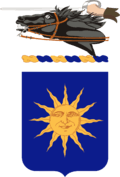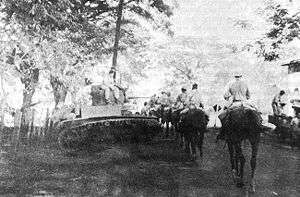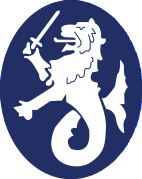26th Cavalry Regiment
| 26th Cavalry Regiment | |
|---|---|
 Coat of arms | |
| Active |
1922–51 1963–88[1] |
| Country | United States |
| Branch | United States Army |
| Type | Cavalry |
| Size | Regiment |
| Garrison/HQ | Fort Stotsenburg |
| Motto(s) | Our strength is in loyalty[2] |
| Engagements | |
| Decorations |
Presidential Unit Citation[3][4] Philippine Presidential Unit Citation |
| Commanders | |
| Notable commanders | BG[5] Clinton A. Pierce[6][7] |
| Insignia | |
| Left & right distinctive unit insignia |
  |
U.S. Cavalry Regiments | |
|---|---|
| Previous | Next |
| 18th Cavalry Regiment | 27th Cavalry Regiment |
The 26th Cavalry Regiment (Philippine Scouts) (26th CAV (PS)) was part of U.S. Army Forces Far East's Philippine Department, during World War II. The 26th engaged in the last cavalry charge in the history of the U.S. cavalry. The American Battle Monuments Commission list 301 dead who were members of this regiment interred at Manila American Cemetery and Memorial.
Formation
The 26th Cavalry was formed in 1922, at Fort Stotsenburg, from elements of the 25th Field Artillery Regiment and the 43d Infantry Regiment (PS).[8] The regiment was based there, with the exception of Troop F (which was based at Nichols Field).[9] In addition to horse mounted troops, the regiment had a HQ Troop, machine gun troop, and a platoon of six Indiana White M1 scout cars, and trucks for transporting service elements.[8] On 30 November 1941, the regiment had 787 enlisted men and 55 officers,[10] and its commander was Col. (later BGen.) Clinton A. Pierce (USA).
World War II combat history
Northern and central Luzon

Following the 1941 Japanese invasion, the 26th participated in the Allied withdrawal to the Bataan Peninsula. In doing so, the unit conducted a classic delaying action that allowed other, less mobile, units to safely withdraw to the peninsula.[11] During the delaying action the 26th provided the "stoutest"[10] and only "serious opposition"[12] of the withdrawal; the majority of the units sent north towards the Lingayen Gulf were divisions (11th, 21st, 71st, & 91st Infantry Divisions) of the untrained and poorly equipped Philippine Army.[12] For instance, during the initial landings the regiment alone delayed the advance of four enemy infantry regiments for six hours at Damortis, and on 24 December repulsed a tank assault at Binalonan.[10] However, the resistance was not without cost, as by the end of 24 December the regiment had been reduced to 450 men.[13][14] Following these events, the regiment was pulled off the line and brought back up to a strength of 657 men, who in January 1942 held open the roadways to the Bataan Peninsula allowing other units to prepare for their stand there.[10]
Bataan
The 26th Cavalry Regiment, consisting mostly of Philippine Scouts, was the last U.S. cavalry regiment to engage in horse-mounted warfare. When Troop G encountered Japanese forces at the village of Morong on 16 January 1942, Lieutenant Edwin P. Ramsey ordered the last cavalry charge in American history.[15][16][17] It would not be until October 22, 2001, when American Soldiers would enter combat on horseback again, when members of the 12-man Operational Detachment Alpha 595 (Green Berets), accompanying members of the Afghanistan Northern Alliance, rode into battle at Cōbaki in Balkh Province.[18]
During the retreat from Bataan, the 26th was heavily outnumbered by an infantry force supported by tanks. They drove off the surprised Japanese. Due to a shortage of food, they found it necessary to butcher their mounts and the regiment was converted to two squadrons, one a motorized rifle squadron, the other a mechanized squadron utilizing the remaining scout cars and Bren carriers.[10]
Guerrilla activities
Following the delaying action down the central Luzon plain, Troop C was cut off from the rest of the regiment, having been ordered into Northern Luzon in an attempt to defend Baguio by Major General Wainwright in late December 1941. In January 1942, the unit, with assistance from 71st Infantry and elements of the 11th Infantry,[19] raided Tuguegarao Airfield,[20] destroying several planes,[21] and killing multiple Japanese soldiers.[19][22] Eventually the unit was supplemented by other soldiers and guerrillas, and remained an effective fighting force well into 1943.[20][23] The remnants of Troop C would later be integrated into the United States Army Forces in the Philippines-Northern Luzon,[21] which due to deaths and captures would be led by Russell W. Volckmann.[24][25] Other guerrilla organizations were led by officers of the regiment, who ignored the surrender orders, or by enlisted men who escaped from Bataan.[26] However, those organizations did not have a direct connection to the regiment, as the Cagayan-Apayao Forces did.
Descendant units
| Philippine Department | |
|---|---|
 Philippine Command Shoulder Sleeve Insignia | |
| Active | 13 January 1911 – 9 April 1942 |
| Country | United States |
| Branch | Army |
| Engagements | Philippines Campaign (1941–42) |
| 110th Cavalry Regiment | |
|---|---|
 110th Cavalry Regiment Distinctive Unit Insignia | |
| Active | 1988–1993 |
| Country | United States |
| Branch | Army |
| Type | Cavalry |
| Motto(s) | Yankee Eyes |
| Engagements | None |
U.S. Cavalry Regiments | |
|---|---|
| Previous | Next |
| 108th Cavalry Regiment | 111th Cavalry Regiment |
The regiment was deactivated in 1946 and completely disbanded in 1951.[27] In February 1963 the regiment was constituted as a unit of the Massachusetts Army National Guard. It consisted of the 1st Squadron assigned to the 26th Infantry Division within the Combat Arms Regimental System (CARS).[1] It was reorganized in 1967, and Troops A, B, and D were transferred to the Massachusetts Army National Guard, and Troop C to the Connecticut Army National Guard. In 1971 Troop D was reallotted to the Rhode Island Army National Guard and in 1986 Troop A was reassigned to Connecticut Army National Guard.[1] In 1988, the regiment was reorganized and redesignated as the 110th Cavalry Regiment; later, in 1989, the regiment was withdrawn from CARS and reorganized under the United States Army Regimental System.[1] The regiment, as the 110th Cavalry, was relieved from the 26th Infantry Division in 1993.[1]
173rd Infantry Detachment of the Rhode Island Army National Guard states that it was formed from the existing troops of Troop D, 1/26th Cavalry in October 1986.[28]
Decorations
| Ribbon | Award |
|---|---|
| Presidential Unit Citation, 3 awards [29][30][31] | |
| Philippine Presidential Unit Citation | |
| Conflict | Streamer | Year(s) |
|---|---|---|
| World War II |
Philippine Islands | 7 Dec 41 - 10 May 42 |
| World War II |
World War II Victory | service between 7 December 1941 and 31 December 1946 |
See also
Notes
- 1 2 3 4 5 Pope, MAJ Jeffrey Lynn; LTC Leonid E. Kondratiuk (1995). Armor-Cavalry Regiments: Army National Guard Lineage. Washington D.C.: National Guard Bureau. p. 28. ISBN 978-0-7881-8206-8. Retrieved 15 February 2011.
- ↑ "26th Cavalry Regiment". Archived from the original on 23 October 2007. Retrieved 31 January 2008.
- ↑ Steve Shaw (4 September 2008). "The Last U.S. Cavalry Charge". Parting Shot. Western Shooting Horse Magazine. Retrieved 22 October 2009.
- ↑ Headquarters, Department of the Army; Major General J.C. Lambert (1961). Unit Citation and Campaign Credit Register (PDF). Department of the Army. p. 75. Archived from the original (PDF) on 11 August 2009. Retrieved 14 November 2009.
- ↑ Young, Donald J. (2009). The Battle of Bataan: A Complete History. Jefferson, North Carolina: McFarland & Company, Inc. p. 108. ISBN 978-0786441808. Retrieved 17 September 2012.
- ↑ Selby, John (2012). The US Cavalry. Osprey Publishing. p. 34. ISBN 9781780967721. Retrieved 17 September 2012.
- ↑ Morton, Louis (2006) [1953]. "VIII. THE MAIN LANDINGS". In Greenfield, Kert Roberts. The Fall of the Philippines. United States Army in World War II. Washington, D.C.: Center of Military History. p. 131. Retrieved 17 September 2012.
- 1 2 Rottman, Gordan (2011). World War II US Cavalry Units: Pacific Theater. Elite Series. Osprey Publishing. p. 32. ISBN 9781780962146. Retrieved 17 September 2012.
- ↑ Gluekstein, Fred (July 2005). "The Last Mounted Cavalry Charge: Luzon 1942". Army. Retrieved 31 January 2008.
- 1 2 3 4 5 Gregory J. W., Urwin (1983). The United States Cavalry: An Illustrated History, 1776-1944. University of Oklahoma Press. p. 186. ISBN 9780806134758. Retrieved 17 September 2012.
- ↑ Merriam, Ray (1999). War in the Philippines. Merriam Press. pp. 70–82. ISBN 1-57638-164-1. Retrieved 31 January 2008.
- 1 2 Morton, Louis (2006) [1953]. "VIII. THE MAIN LANDINGS". In Greenfield, Kert Roberts. The Fall of the Philippines. United States Army in World War II. Washington, D.C.: Center of Military History. p. 136. Retrieved 17 September 2012.
- ↑ Morton, Louis (2006) [1953]. "VIII. THE MAIN LANDINGS". In Greenfield, Kert Roberts. The Fall of the Philippines. United States Army in World War II. Washington, D.C.: Center of Military History. p. 138. Retrieved 17 September 2012.
- ↑ Fredriksen, John C. (2010). The United States Army: A Chronology, 1775 to the Present. ABC-CLIO. p. 260. ISBN 9781598843446. Retrieved 21 September 2012.
- ↑ Elaine Woo (17 March 2013). "WWII cavalry officer in the Philippines". Los Angeles Times.
- ↑ Phil Davison (3 April 2013). "Lieutenant-Colonel Edwin Ramsey: Soldier who led the last cavalry charge by the US army". The Independent.
- ↑ John Skow (23 November 1987). "In Kansas: Echoing Hoofbeats". Times Magazine. Retrieved 12 May 2009.
- ↑ Zimmerman, Dwight Jon (September 16, 2011). "Operation Enduring Freedom: The First 49 Days". Retrieved 15 January 2012.
- 1 2 "Guillermo Nakar" (PDF). National Historical Institute. Republic of the Philippines. Archived from the original (PDF) on 8 March 2012. Retrieved 15 February 2011.
- 1 2 "The Intrepid Guerrillas of North Luzon". BOOK REVIEW. Defense Journal. 2002. Archived from the original on 23 March 2010. Retrieved 21 May 2009.
- 1 2 "Bataan Diary: Research". Chris Schaefer. Retrieved 15 February 2011.
- ↑ Norling, Bernard (2005). The Intrepid Guerrillas of North Luzon. Lexington, Kentucky: University Press of Kentucky. pp. 43–62. ISBN 978-0-8131-9134-8. Retrieved 21 May 2009.
- ↑ Norling, Bernard (2005). The Intrepid Guerrillas of North Luzon. Lexington, Kentucky: University Press of Kentucky. p. 284. ISBN 978-0-8131-9134-8. Retrieved 21 May 2009.
- ↑ Guardia, Mike (2010). American Guerrilla: The Forgotten Heroics of Russell W. Volckmann: The Man Who Escaped from Bataan, Raised a Filipino Army Against the Japanese, and Became 'father' of Special Forces. Havertown, PA: Casemate Publishers. p. 98. ISBN 1-935149-22-9. Retrieved 15 February 2011.
- ↑ Falk, COL Stanley L. (2010). "Guerrilla Warfare in the Philippines" (PDF). Army. Association of the United States Army. 60 (9): 85–88. Archived (PDF) from the original on 17 February 2011. Retrieved 15 February 2011.
- ↑ "Last of cavalrymen a true hero". Old Gold & Black. Wake Forest University. 6 March 2003. Archived from the original on 16 September 2008. Retrieved 21 May 2009.
- ↑ "Records of the 26th Cavalry Regiment (Philippine Scouts): A Descriptive Inventory of Documents in the U.S. Cavalry Memorial Research Library" (PDF). U.S. Cavalry Memorial Research Library. Archived from the original (PDF) on 24 July 2007. Retrieved 9 December 2009.
- ↑ "173rd Infantry Detachment – Long Range Surveillance". Rhode Island National Guard. Archived from the original on 6 June 2010. Retrieved 30 March 2009.
The 173rd Infantry Detachment started out it's [sic] existence as the Scout Platoon, Troop D, 1/26th Cavalry. When Troop D was reorganized in October, 1986 the scout platoon was no longer required and subsequently reformed into a long range surveillance detachment. The split from Troop D officially made this a new unit which does not share history from Troop D. This units first assignment continued with the 1st Squadron, 26th Cavalry Regiment.
- ↑ (North Luzon Force, United States Army Forces in the Far East. Cited; War Department General Order # 14, 1942).
- ↑ (Army Troops, United States Army Forces in the Far East. Cited; War Department General Order #32, 1942.)
- ↑ (Military and naval forces of the United States and Philippine Governments. Cited; War Department General Order #22, 1942, as amended by Department of the Army General Order #46, 1948).
References

External links
- 26 Cav at philippine-scouts.org
- Edwin Price Ramsey Web site Lt. Ramsey led the cavalry charge at Morong, mentioned in this article.